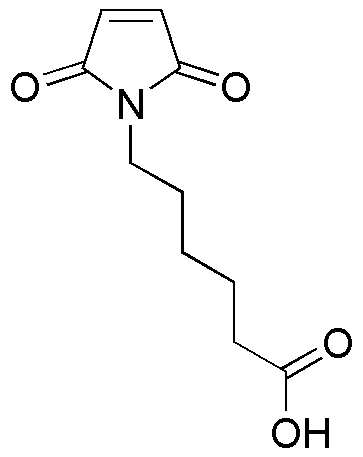6-Maleimidocaproic acid is widely utilized in research focused on
- Bioconjugation: This compound is essential for linking proteins and peptides to other molecules, such as drugs or imaging agents, enhancing their effectiveness in targeted therapies.
- Drug Development: It plays a crucial role in the design of novel therapeutics, particularly in creating antibody-drug conjugates that allow for more precise treatment of diseases like cancer.
- Diagnostics: The chemical is used in the development of diagnostic tools, enabling the attachment of biomarkers to surfaces for improved detection of diseases.
- Material Science: It is applied in the creation of functionalized surfaces, which can be used in biosensors and other advanced materials, improving their performance and specificity.
- Research Reagents: As a versatile linker, it is commonly used in laboratories for various research applications, facilitating studies in protein interactions and molecular biology.
Informations générales
Propriétés
Sécurité et réglementation
Applications
6-Maleimidocaproic acid is widely utilized in research focused on
- Bioconjugation: This compound is essential for linking proteins and peptides to other molecules, such as drugs or imaging agents, enhancing their effectiveness in targeted therapies.
- Drug Development: It plays a crucial role in the design of novel therapeutics, particularly in creating antibody-drug conjugates that allow for more precise treatment of diseases like cancer.
- Diagnostics: The chemical is used in the development of diagnostic tools, enabling the attachment of biomarkers to surfaces for improved detection of diseases.
- Material Science: It is applied in the creation of functionalized surfaces, which can be used in biosensors and other advanced materials, improving their performance and specificity.
- Research Reagents: As a versatile linker, it is commonly used in laboratories for various research applications, facilitating studies in protein interactions and molecular biology.
Documents
Fiches de données de sécurité (FDS)
La FDS fournit des informations de sécurité complètes sur la manipulation, le stockage et l’élimination du produit.
Spécifications du produit (PS)
Le PS fournit une description complète des propriétés du produit, notamment sa composition chimique, son état physique, sa pureté et les exigences de stockage. Il détaille également les plages de qualité acceptables et les applications prévues du produit.
Certificats d'analyse (COA)
Recherchez des certificats d'analyse (COA) en saisissant le numéro de lot du produit. Les numéros de lot et de lot se trouvent sur l'étiquette d'un produit, après les mots « Lot » ou « Lot de fabrication ».
Numéro de catalogue
Numéro de lot/série
Certificats d'origine (COO)
Ce certificat d'exploitation confirme le pays dans lequel le produit a été fabriqué, et détaille également les matériaux et composants utilisés et s'il est issu de sources naturelles, synthétiques ou autres sources spécifiques. Ce certificat peut être requis pour les douanes, le commerce et la conformité réglementaire.
Numéro de catalogue
Numéro de lot/série
Fiches de données de sécurité (FDS)
La FDS fournit des informations de sécurité complètes sur la manipulation, le stockage et l’élimination du produit.
DownloadSpécifications du produit (PS)
Le PS fournit une description complète des propriétés du produit, notamment sa composition chimique, son état physique, sa pureté et les exigences de stockage. Il détaille également les plages de qualité acceptables et les applications prévues du produit.
DownloadCertificats d'analyse (COA)
Recherchez des certificats d'analyse (COA) en saisissant le numéro de lot du produit. Les numéros de lot et de lot se trouvent sur l'étiquette d'un produit, après les mots « Lot » ou « Lot de fabrication ».
Numéro de catalogue
Numéro de lot/série
Certificats d'origine (COO)
Ce certificat d'exploitation confirme le pays dans lequel le produit a été fabriqué, et détaille également les matériaux et composants utilisés et s'il est issu de sources naturelles, synthétiques ou autres sources spécifiques. Ce certificat peut être requis pour les douanes, le commerce et la conformité réglementaire.


